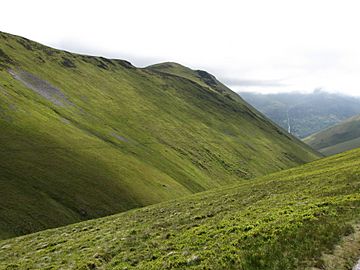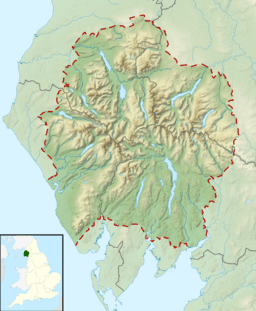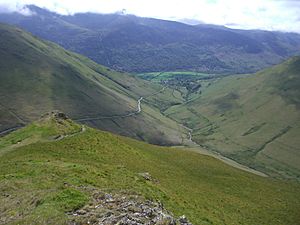Knott Rigg facts for kids
Quick facts for kids Knott Rigg |
|
|---|---|

Viewed from near the source of Rigg Beck.
|
|
| Highest point | |
| Elevation | 556 m (1,824 ft) |
| Prominence | 61 m (200 ft) |
| Parent peak | Ard Crags |
| Listing | Wainwright |
| Geography | |
| Location | Cumbria, England |
| Parent range | Lake District, North Western Fells |
| OS grid | NY197188 |
| Topo map | OS Landranger 89, 90 OS Explorer 4 |
Knott Rigg is a 'fell' (a type of small mountain or hill) located at the top of the Newlands Valley in the beautiful Lake District area of England. It is found about 8.5 kilometers southwest of the town of Keswick. Knott Rigg is not very tall, only 556 meters (1825 feet) high.
Its name comes from the Old English language and means "hill on a knobbly ridge." Even though it's not tall enough to be on the main lists of big mountains, Knott Rigg is special. It has its own chapter in Alfred Wainwright’s famous guidebooks, called Pictorial Guide to the Lakeland Fells.
Contents
Where is Knott Rigg Located?
Knott Rigg is part of a long ridge, about four kilometers long. This ridge starts near Rigg Beck in the Newlands valley. It then stretches southwest and ends at a place called Newlands Hause.
The ridge also includes a nearby small mountain called Ard Crags. Ard Crags is about 1.5 kilometers northeast of Knott Rigg. People often climb both Knott Rigg and Ard Crags together on the same trip.
How Knott Rigg Looks
Knott Rigg has steep sides. On its west side, the land drops down to the valley of Sail Beck. The east side goes down to a small road that connects Keswick and Buttermere in the Newlands valley.
You can get a great view of Knott Rigg from Newlands Hause. From there, it looks like a sharp, cone-shaped peak. You can also see a full picture of the fell from Buttermere, though it might look a bit far away.
What is Knott Rigg Made Of?
The ridge where Knott Rigg and Ard Crags are found is made of a type of rock formation called the Buttermere Formation. This formation includes different kinds of rock that have been mixed up and folded over time. These rocks are mostly mudstone, siltstone, and sandstone.
You can also find small amounts of basalt rock on Knott Rigg. Basalt is a dark, fine-grained volcanic rock.
How to Climb Knott Rigg
The easiest way to climb Knott Rigg is to start from the car park at Newlands Hause. This starting point is already quite high up, at 333 meters. This means you only need to climb a little over 200 meters to reach the top.
You can also start your climb from further down in the Newlands valley. Some people begin their walk at Keskadale Farm or Rigg Beck. If you choose the Rigg Beck route, you will climb Ard Crags first before continuing on to Knott Rigg.
Views from the Top of Knott Rigg
The views from the very top of Knott Rigg are a bit limited. This is because there are many taller hills all around it, like the Coledale and Buttermere Fells.
However, if you look to the east, between Causey Pike and High Spy, you can see some amazing sights. From this spot, you can enjoy views of the Skiddaw and Helvellyn ranges, which are two other famous mountain areas in the Lake District.



